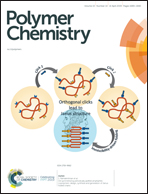Synthesis of strictly alternating copolymers by living carbanionic copolymerization of diphenylethylene with 1,3-pentadiene isomers†
Abstract
A well-defined strictly alternating copolymer was synthesized via the living anionic copolymerization of 1,3-pentadiene (PD) isomers with 1,1-diphenylethylene (DPE) in cyclohexane using n-BuLi as initiator. Intriguingly, the novel copolymer appeared to exhibit a much higher degree of alternation since neither DPE nor PD isomers are capable of forming homo-polymers within 24 h below 30 °C, and DPELi is also unable to cross-initiate the PD isomers due to its huge steric hindrance. Herein we investigated the DPE/PD copolymerization kinetic results, which are affected by solvent, temperature and PD isomer, as well as the comonomer feeding ratio. The results showed that the copolymer yield reached a maximum when an equimolar feeding ratio of the comonomer pair is maintained in a non-polar solvent. Meanwhile, the copolymerization rate of cis-1,3-pentadiene (CP) with DPE is much higher than that of the trans isomer (TP), as the formed zwitterion compound (DPC) derived from the DPE/CP pair shows higher reactivity when it is attacked by carbanionic species. In particular, the PD/DPE (1/1) copolymerization initiated by n-BuLi yielded living, well-defined, alternating (rDPE·rPD = 0, rDPE = 0 and rPD ≈ 0 below 30 °C) and quantitative copolymers with controllable Mn and low ĐM (1.15–1.39). From a comparison of the apparent propagation rate constants kappp, the order of copolymerization activity was as follows: cis ≈ mixed isomer > trans. The values of the apparent activation energies Eappa for the isomer copolymerizations were calculated to be 52.60 kJ mol−1 and 47.95 kJ mol−1 for the trans and cis isomers, respectively. The first-order kinetic resolution and NMR spectra demonstrated that the obtained copolymers possess strictly alternating repeating units containing 1,4-/1,2-chains in a ratio of 88%/12%, and no 3,4-units. The DSC results showed that the copolymers were amorphous with Tg of 93–97 °C, and that the non-crystallinity may have contributed to the 12% 1,2-units randomly incorporated into the macromolecular chain. FTIR spectroscopy showed that the 1,4-PD chains were predominantly trans-1,4 rather than cis-1,4 units. In general, the copolymerization behavior is somewhat similar to the free radical alternating copolymerization of CTC compounds. The formation of a macro zwitterion (DPC) through the distribution of electronic charges from the donor (PD isomer) to the acceptor (DPE) is proposed in the carbanion alternating copolymerization mechanism.



 Please wait while we load your content...
Please wait while we load your content...